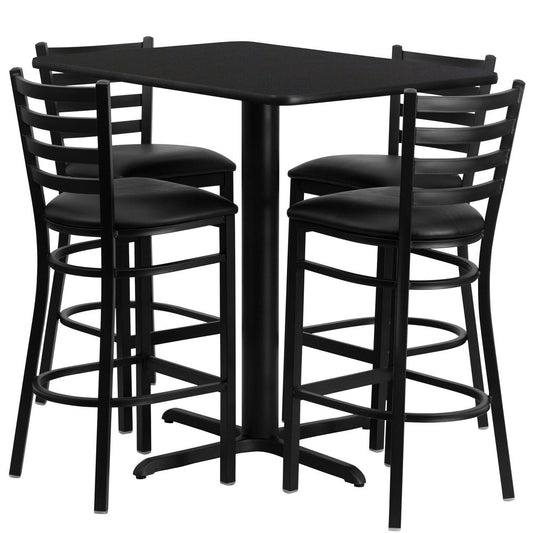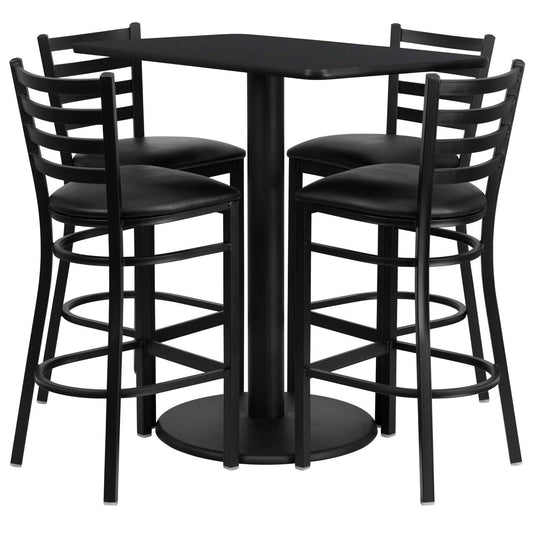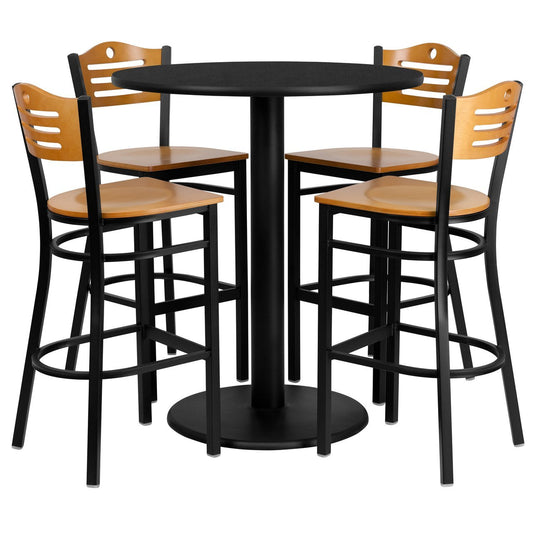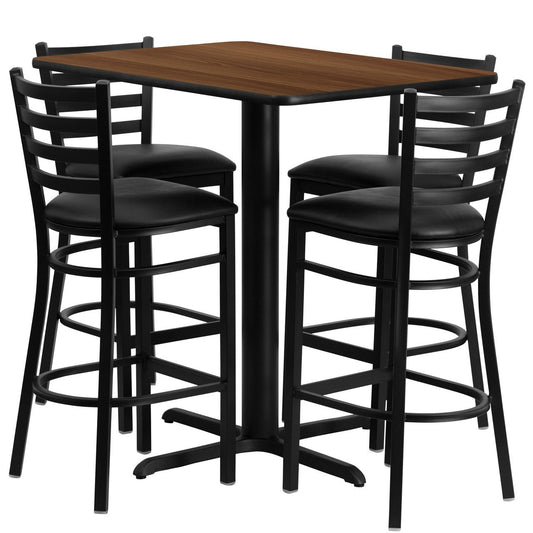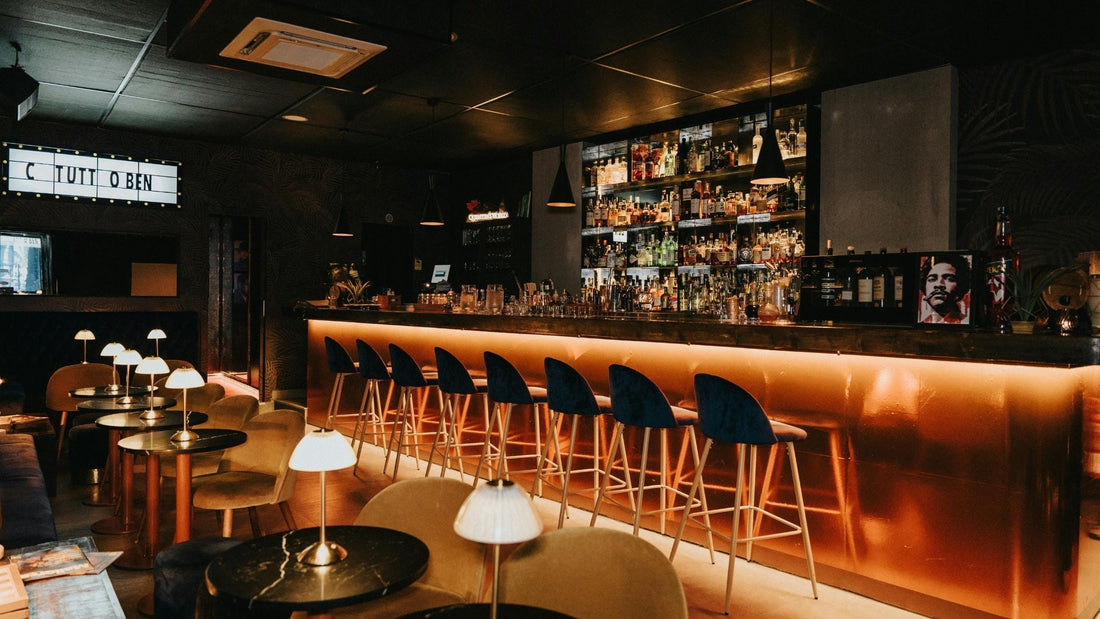
Material Comparison: Metal vs. Wood Stools for Restaurant Seating
Share
The selection of chairs for restaurants is not just based on interior or design, but it determines the character, utility, and overall experience of the restaurant. Among the many types of seats, the most commonly used are luxury metal barstools, especially in bars, cafes, and other places where space and look are prioritized. But when it comes to selecting the right stool material, restaurant owners are often faced with a dilemma: Metal or Wood?
In today’s blog post, we will explain the differences and benefits of metal and wood stools and how each material can work to the advantage of a restaurant.
1. Aesthetic Appeal: Comparing the Visual Impact of Metal and Wood Stools
Restaurants are judged by their appeal and charm, and this is where stools are useful in giving the desired look.
Metal Stools:
Metal bar stools can be termed modern stools, industrial stools, and minimalist stools. It is available in different designs and shapes, but many are slim, sleek and come in different colors, stainless, chrome plated or other powder colors. Such stools are ideal for use in urban areas where people do not need or prefer the more traditional style of a classic designed chair.
In addition, there are several significant benefits associated with the use of metal stools, and this is because they can be colored to match or complement the color and design of most eating joints. For example, high-gloss gives a luxurious look to an endeavor while matte on the other hand gives a professional look to an endeavor.
Wooden Stools:
On the contrary, wooden bar stools are comfortable, attractive, rich and natural chairs that offer warmth consistent with the material. They are flexible and can be made with very simple finishes, which can range from a natural look to a very elegant finish that appeals to restaurants. Depending on the grain, texture and color of the wood, it offers a wide range of designing variations. Basically, wooden stools are quite versatile for interior design and can be easily incorporated into country comfort, relaxed, shabby chic, industrial or minimalism styles.
Wood also provides a tactile feel that cannot be easily provided by metal. The intricate grain patterns of wood can be perceived as positive and trustworthy while metal may not give such responses.
2. Durability and Longevity: Which Material Stands the Test of Time?
Durability is of utmost importance when choosing restaurant furniture because the seating area will be used every day and will likely be subjected to multiple wear and tear.
Metal Stools:
Metal stools have great features such as strength and are therefore popular. They are less likely to break, bend, or be damaged by impact and they can handle extreme use. Of course, metal stools are most useful where chairs are often bumped and moved or where many customers use the furniture – such as in bars or eateries.
In addition, metal stools do not deteriorate from most environmental factors such as humidity, so they can be used both indoors and outdoors. They do not suffer the kind of potential damage to wood that is triggered by drops or humidity fluctuations.
Wooden Stools:
Although wooden stools are also considered functional, they tend to wear out faster than metal stools. Wood has its drawbacks: the stool is prone to scratches, dents, or chips when it is rearranged frequently or exposed to sharp impacts. Nevertheless, these stools can be brought back to their original good condition as wooden stools can always be repaired, sanded, and refinished.
For example, the durability of wooden stools largely depends on the type of wood used. It is better to use materials such as oak, maple, or walnut as they are stronger and do not get worn or damaged easily compared to pine or fir wood. If maintained well, wooden stools are durable and they add their own identity due to their professionally polished finish.
3.Comfort and Ergonomics: How Material Choices Affect Customer Experience
Another factor is also important for the customer perception and that is the comfort level. Depending on the location and environment it is possible that properly chosen seating increases the time the customers spend there.
Metal Stools:
On the one hand, metal stools are very popular today due to their appearance and ease of cleaning; but, on the other hand, they do not invoke sitting. Metal surfaces are commonly ‘hard’ and ‘cold’, these are feelings that customers might not easily be comfortable with. To counter this, most metal stools are often designed with a padded seat, or cushions, where the padding helps to enhance comfort while equally improving the stool’s outlook without compromise.
The design of metal stools as far as the ergonomics of their structure is concerned can also be quite different. There are ones with curved surfaces of the sitting as well as the backrest area that embrace the body; the others may seem more like industrial-like metal stools. When selecting metal stools, customers should pay attention to style and whether it provides ample cushions and adequate backrests for sitting for an extended period.
Wood Stools:
Wood stools are normally more comfortable to use than metallic stools especially if the stools are unpadded. Wood, in its essence, is warmer and there is a certain degree of softness in the material that can definitely contribute to the comfort in using the seating area. Most wooden stools were specifically designed to have seats and a backrest section that helps the correct sitting posture and be as comfortable as possible.
In the same manner, wooden stools are felt heavier than plastic made stools or other material alike and they add to the strength and ease of an individual who uses it. The feel, warmth, and flexibility of wood can also add to the whole dining experience, and customers will be more relaxed.
4. Maintenance and Care: Evaluating the Effort Required to Keep Stools Looking Their Best
Another important factor for the restaurant owners it’s maintenance – the easier it is to maintain a given equipment, the better. Maintenance of the stools cannot be overemphasized as easy-to-clean and maintained stools help in cutting costs in the long run.
Metal Stools:
Metal bar stools are quite easy to clean and are not much trouble with any requirements of maintenance frequently. They can be cleaned just with a moist cloth and a little bit of soap; thus, they should look good always. Metal is also non-porous, and stains do not adhere to the surface thus, any splatter can be wiped with ease without leaving a stain.
However, some metal stools may rust and or fade with time; they may need to be polished once in a while, especially if they have a chrome or brushed steel look. Looking at the other options of stools made of metals, the main disadvantage which might be observed in the stools over the period is the process of rusting, especially in case the humidity in the house is high or metal stools are placed outside. Rust is also a big problem, but if these bumps are checked often and any rust spots are treated immediately, their life span can be extended.
Wood Stools:
Wood stools are somewhat more delicate than metal stools for instance. It has to be washed, but it has to avoid coming in contact with a lot of water, as this will result in the wood shrinking, swelling, or cracking. Daily dusting and once in a while polishing with a wood conditioner will help in retaining the sheen on the wood and ensuring it does not dry.
Food or drink spills should be wiped off immediately so as not to cause staining of the wood While using the furniture you can place coasters or placemats to prevent scratching of the wood. Wood stools may also require a new coat once in a while especially if there is a lot of usage to bring back the finish and to seal the wooden surface.
5. Cost Considerations: Weighing the Initial Investment and Long-Term Value
The cost of seating is one of the areas of essence for the restaurant business, especially concerning the interior design of a vast area.
Metal Stools:
Metal stool tends to be cheaper when compared to wooden stools, meaning that restaurant owners will find it easy to buy them due to the low prices. The process of manufacturing metal stools is easier and the material used to make the stools is cheaper hence the cost of manufacturing is lower.
Also, since metal stools are rigid and grant less treatment than that of a wooden stool, they can end up being cheaper in the long run. The startup costs are probably lower and the stools themselves will not likely wear out and need replacement as soon as in this case.
Wood Stools:
There is usually a difference in the cost of wood stools, differences that are usually occasioned by the type of wood that has been used. The complexity of engendering wood stools also leads to higher costs since more effort is channeled into the manufacturing of the stools. But if one looks on the flip side, wood stools can better be justified for the higher price since matters such as the ambiance and the comfort of customers are well valued by some bar owners most especially in fine dining restaurants.
Although wood stools may still need more attention from time to time in terms of washing and refinishing, the durability of wood stools and the elegant look they provide make it worthwhile. Hence, for restaurants that want to bring a warm feeling to the premises, the added costs of wood stools could indeed be beneficial, especially when selecting high-quality restaurant furniture that enhances the overall ambiance.
6. Environmental Impact: Considering Sustainability in Material Choices
One factor that has gained more attention in companies and organizations is sustainability and it applies to restaurants.
Metal Stools:
Metal stools can be green and they are made out of recycled material for instance. These materials include aluminum and steel and many manufacturers recycle metals to make stools. For a similar reason, metal stools can be used for many years before they wear out: they are not discarded as frequently as disposable plastic stools.
That said, the process of manufacturing metal can be very energy hungry and the procurement of the raw materials is also known to hurt the environment. To cater to the green aspect, restaurateurs should ensure that the stools used in the restaurants are made of metal and should be from recycled material or even from environmentally friendly manufacturers.
Wood Stools:
Despite this, when procured correctly, wooden stools are one of the most eco-friendly solutions. Timber is a renewable material and several furniture producers have stools that have been made from environmentally sensitive sources or recycled timber. Also, it is important to note that wood has a low emission factor, especially in the carbon footprint when compared to metal if it has been sourced locally.
As for the environmental consequences of the wood stools, one has to mention that it fully depends on the type of wood used and the process it underwent. Sustainability conscious restaurants should go for stools with certified sustainable wood or stools made out of recycled or reused woods.
7. Versatility and Customization: Tailoring Stools to Fit Specific Restaurant Needs
Another one of the key factors of the choice of furniture, popular among restaurateurs, is the flexibility to match the seats to the requirements and design of the place.
Metal Stools:
The metal stools comprise a high level of adjustability. They can be painted, powder coated, or anodized in several colors to suit the decor of the restaurant. Metal can also be bent and shaped so that various forms of designs can be made on the seat to come up with new and creative seating solutions. Certain metal stools are built with the capability of height control, the feature of rotation, or stackability which plays an important role in flexibility.
Wood Stools:
Wood stools also come in the same range of sizes and may thus be considered as having customization flexibility, but they furnish a different type of flexibility. The actuality of the wood grain and the natural differences in the color of the woodwork make each stool different and add to the overall warmth of the environment. They can be treated using several styles ranging from the natural or the raw look, to be stained, painted, or finished. Additional carving, engraving, or upholstery to the wooden stools can be undertaken to meet the particular theme of the restaurant.
Conclusion: Making the Right Choice for Your Restaurant's Unique Needs
There is no clear winner when it comes to metal vs wooden stools for restaurant seating. All materials have their benefits and drawbacks and therefore, the proper choice depends on the requirement, direction, and cost of the restaurant.
Metal stools also work best in today's commercial spaces, especially where the emphasis is on the use of raw industrial products that are easy to maintain. They are easy to install, they are affordable and they can be molded into different designs that will fit any design alignment. Wooden stools on the other hand exude warmth, comfort, and even class that can enhance the customer's look. These are excellent for planning spaces that need to be warm and welcoming and can be a cost-effective investment despite the slightly higher purchase price and care required.
Therefore, the decision between metal and wooden stools should be in keeping with the general purpose of the restaurant so that the seats that are provided are suitable for the decor as well as the conveniences of the restaurant. Taking into account all the factors mentioned in this comparison it is possible to make a proper choice that will positively influence the future development of the restaurant business.

